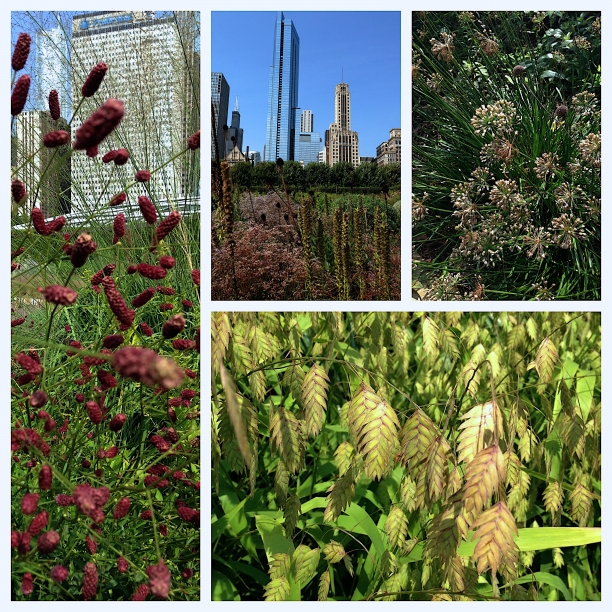Always try to keep a patch of sky above your life. Marcel Proust | Swann's Way
General
Always try to keep a patch of sky above your life. Marcel Proust | Swann's Way
The first image in the Proust project is old books. An excerpt of the introductory quotation: For a long time I would go to bed early. Sometimes, the candle barely out, my eyes closed so quickly that I did not have time to tell myself: “I’m falling asleep.” And half an hour later the thought that it was time to look for sleep would awaken me; I would make as if to put away the book which I imagined was still in my hands, and to blow out the light. Marcel Proust Swann's Way
Visual prototypes for this section are underway. Drawing on the palette of wines and ambers of old books, the notion of activation and accessing fragments of long-term memories is conveyed using a combination of color and grayscale.
Next up in the series: hawthorns in pink. Read more about this project here.
I have long had a vague feeling that I should read Proust. I notice Swann's Way on the bookshelf and wonder what I'm missing out on. But I also gathered that reading Proust would be a long, slow slog. And so I had not read Proust...until this past month when I was asked to develop visuals for a book on Proust. The author of this project, Dr. Barry, is a long-time acquaintance. Dr. Barry has followed my work for a number of years. We had an immediate connection given that as a psychiatrist Dr. Barry has a deep understanding of the concepts that drive my art: consciousness, memory, the autobiographical self, embodied cognition.
I read Swann's Way over the winter break. It's a long read. It took a while to get comfortable with the rhythm. And there are sections that drag. But, there's plenty of pure magic. Proust creates a shimmering work of art with words. He gives linguistic form to the fleeting sensations and impressions of consciousness, reconstructing long term memories into layered visual metaphors. There are numerous reflections on creativity and the creative process. And his narrative is deeply informed by visual experience. He is attuned to light and dark, shadows and contrast. Color and form in the natural world are noticed, as are textures and surfaces of the built world. Proust notices sunlight weaving threads of golden silk, ribbons of moonlight splintering across the surface of water, the shifting visual images of sunlit stained glass windows.
The art pieces will offer visual metaphors to connect with both literal images and concepts about which Dr. Barry will write in each section. It is an interesting challenge to think about how art images will read as static photographs on a page. I proposed a 2-page layout for each section. On one page, an introductory quotation by Proust will be accompanied by 2-3 instagram-style images of the literal object or image associated with the quotation. The photographs are to be gestural, abstracted glimpses that evoke the literal imagery. For the glass pieces, I wanted to create a series that was conceptually and visually coherent; for the 8-10 art images to make sense across the sections of the book. I developed a collaged composition that gives me flexibility to weave together the various visual elements that will recur across the pieces.
The central motif of the constructive nature of memory is represented in a mechanical or structural form of circles and half-circles.The concept of synaptic transmission and signaling is reduced down to its essence with straight lines of glass stringer and pops of gold. Abstracted text elements point to the written form of Proust's art. It also connects to the mediation of memory by language. Recall and reconstruction of memories is dependent on the symbolic code of language. Abstracted foliage elements point to Proust's passion for the organic world; the flourishing gardens and vines and blossoms serve as an extended visual metaphor for the creative process throughout the text. Other elements are introduced section-by-section.
First up: old books.
Transform Invited design proposal | Art-in-Architecture Program | State of Illinois
16" x 16" prototype | glass with glass stringer and hardware
Design proposal for a feature wall installation for the Engineering Sciences and Technology program at Parkland College, Champaign, IL. Hard-edged line and geometries of an industrial vocabulary are integrated with abstracted forms inspired by the natural world.
I created a 1/3rd scale prototype of a small section of the full 66SF glass composition to help visualize the color and glass palette of the proposed piece. I used thinner glass stringer rather than glass rod to keep the proportions appropriate for the smaller scale piece. A laser level was used to set the stringer.
Transform re-imagines forms and processes of the Engineering Sciences department as a visual narrative. Transform celebrates the extraordinary technical expertise that is learned and applied at Parkland College. This visual abstraction draws on modernist visual tropes of beauty in structure and function, making it accessible to viewers by connecting them with imagery from the natural world. Transform connects art and design with manufacturing and production at both a conceptual and material level.
Full set of images of Transform prototype can be found here.
Invited design proposal Art-in-Architecture Program
State of Illinois
The last number of weeks have been focused on developing a design proposal for a ~225SF feature wall for the Engineering Sciences Department at Parkland College in Champaign, IL. I was one of four artists invited to submit proposals for the space. The creative brief stipulated only that durable materials be used to ensure a low-maintenance installation and that concepts need not be limited to the industrial arts in theme.
When I toured the building in early December I found a spectacular architect-designed industrial chic space with functional elements used as design features, gleaming polished concrete floors, and white ceiling and walls flooded with natural light from a huge skylight. The lighting conditions are perfect for that materials I use in my work.
The concept that began to take shape was one of transformation. The story is about raw materials transformed into finished products; a spark transformed into velocity. Or the story of human creativity transforming information into knowledge and expertise. Ultimately given the bucolic setting of the surrounding farmland, it is also a story about the land: light transformed into grain.
For the full composition, I re-purpose industrial materials as conceptual media. Glass, paint, metal cladding, MDF insets and hardware all echo the industrial aesthetic of the technical equipment and workspace I observed during my December visit. Hard-edged beauty of the geometry, precise lines, and perfect forms of engineering sciences technology are imagined as flowing elements inspired by the social and natural world of Parkland College. This visual abstraction draws on modernist visual tropes of beauty in structure and function, making them accessible to viewers by connecting them with imagery from the natural world.
Transform connects art and design with manufacturing and production at both a conceptual and material level.
I presented this concept to a panel of 12 jurors in Champaign last week. While my concept was not selected, this project pushed me way forward in figuring out how glass can be integrated alongside other architectural surfaces and materials. It creates all sorts of interesting possibilities. Meeting with metal fabricators and millworkers has given me a whole new range of ideas about using architectural materials as compositional elements.
I will say that the process of essentially blindly pitching an idea was less than ideal. While I saw the space and got to ask a few questions about the community, the Arts-in-Architecture process doesn't allow for dialogue with the architects and community of users. In the end, the feedback was that the metal cladding was too dark in the space. There are multiple other materials that I could have proposed but after literally weeks of work there is no opportunity in the process for this kind of dialogue with the clients. So. I will continue on my quest to collaborate with designers and architects, developing site-specific art solutions that infuse a space with meaning and interest. Onward.
Jason Peot was awarded this commission and his light installations are simply stunning. I was in good company with ceramic artist Jason Messinger and my longtime friend mosaic genius Jim Bachor.
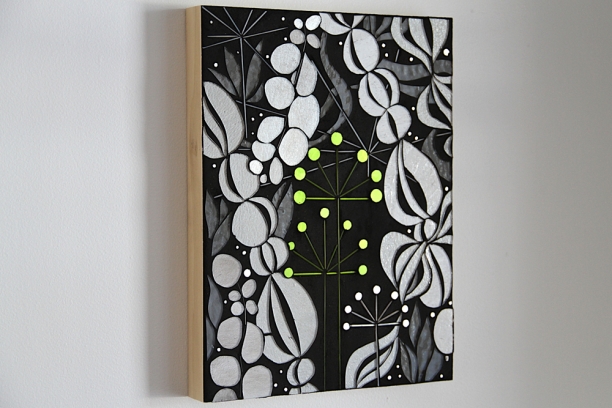 I often find myself drawing foliage and botanical forms in the dead of winter. Partly because I love deadheads; forms reduced to their structural essence.
I often find myself drawing foliage and botanical forms in the dead of winter. Partly because I love deadheads; forms reduced to their structural essence.
And partly because I believe in E.O. Wilson's concept of Biophilia--we are naturally attuned to things that are alive and vital and vibrant. In the middle of (a particularly long) winter, I crave growing, curving forms. Bloom 4.3 is another experiment with glass stringer. Those tiny threads of glass create lovely structural lines within the flowing organic shapes. I see this work as part of my inquiry into how to live well in an urban environment. We need to find new ways of seeing beauty and staying connected to nature.
More pieces are coming in this series in preparation for a hanging at Creative Co-Working in Evanston later this spring.
This week I'm cleaning up the studio and completing an up-to-date art inventory to prepare for the start of the new year. These are the Blooms that are left in my studio. I love my urban flowers. I first started working on Bloom in the dead of winter a number of years ago and literally was craving color in the dark, black+white winter. The popping squared blooms with the graphic foliage belong as much to the urban, built world as to the natural world, a point of intersection that I'm always exploring.
Ornaments you get to keep up year round.
Impel is a series I've been exploring for a number of years. It started as a tiny inset in a friend's backsplash with turquoise and spring green and ambers. The concept came from the thinking about how the social landscape is constantly evolving: we change and are changed by others around us. For Impel 4.0, I used tightly cropped images of the interacting elements. This was my first time to use this lovely coral glass. The glass comes clear and requires kiln firing to realize the rich coral color (many thanks to my glass artist friend Paul Messink for firing it for me). The palette of purples and corals and ambers are luminous against the black grout.
See more about Impel 4.0 here.
My first public art mural, Link, is complete. I think Link succeeds in creating an engaging visual experience. I had creative freedom and the chance to realize the my largest piece yet in a short period of time. The problem with public art, however, is what exactly is the point of doing a large exterior piece for a less-than-market-value stipend that some community members will love, some will hate and many will never notice? Here's my thinking:
1. Andersonville has long been a favorite neighborhood for me. Andersonville has always had an appealing cohesive urban aesthetic. It's the closest go-to place for those of us in the far north neighborhoods needing art galleries and interesting design shops and good scones. During my previous career in healthcare, I worked at nearby hospitals, first Ravenswood then Weiss in Uptown with a satellite clinic in Edgewater. Andersonville was an inviting destination for post-work happy hours and dinners out. I love the idea of being back in Andersonville to make art and contribute to well-being in a completely different way.
2. Andersonville has a longstanding commitment to creating inviting public spaces. The corner of Clark and Bryn Mawr features signature Andersonville wrought iron benches, a beautifully maintained concrete planter and lovely tile and concrete insets in the sidewalk. An art piece could extend this compelling public space along the span of the building.
3. The masonry wall itself is lovely with smooth, uniform dark red brick. I am obsessed with connecting my work with industrial surfaces. While I love the symmetry and regularity of industrial surfaces, we also need variation and difference. In the natural world, we find the perfect balance of repetition and variation. Rather than treating the masonry wall as a canvas to be covered, I love the idea of the masonry wall being an element in the piece. Varying the repetition of brick and concrete, viewers can be re-connected with an overlooked surface in the streetscape. From either end, the painted lines virtually disappear against the brick.
4. This is a busy pedestrian corridor and the majority of viewers will see the piece as they walk by the 35' span of the building. I am passionate about the power of glass to engage a viewer. Glass comes to life with light and movement. I could see a fantastic creative opportunity to create a compelling walk-by experience, offering coherent changes in form and intensity of painted elements animated by glass elements in lush shimmering color.
5. The project budget was small and necessitated a mixed media concept that could be executed quickly. This is a difficult topic for public artists and I fall decidedly on the side of creative content being properly valued and artists paid at market value. Tim Kreider's recent opinion piece in the New York Times provides an excellent synthesis of this issue: Slaves of the Internet Unite. My decision to take on this project was a calculated gamble that realizing a 200SF art piece will lead to more opportunities. I developed a composition primarily for paint with a small number of glass elements floating in relief along the wall. This mixed media approach kept costs down while at the same time creating strong visual contrasts and bringing dimension to the piece.
Overall, my approach to public art is rooted in my understanding of cognition--humans thrive in engaging environments. I see public art as an opportunity to create moments of surprise and discovery. Living in urban landscapes requires new ways of seeing beauty and finding the variation we need to offset the predictability of the built environment. In the case of Link, coherent changes in form and intensity punctuated by shimmering glass elements across the 30′ span are intended to vary the repetition of the masonry. This hopefully creates an engaging walk-by experience, infusing pedestrian commutes with interest and meaning. Upon final analysis, I am delighted to have been able to make a tiny contribution to Andersonville's lovely urban landscape, maybe even helping others 'live well' in our urban world.
The original drawing of Link featured layered blues with pops of orange and amber. Running at the lakefront has made me see blues in a new way. Water and sky is endless dynamic with infinite numbers of different blues and in infinite combinations. The RFP called for a concept that evoked water. So I had blues as the starting point for my drawings.

I created a sample glass palette to help visualize color--even went and attached it to the masonry wall to see how the colors worked with the red brick.
[image]
The translation of color from glass to paint was hard. The dynamic nature of glass--shifting and shimmering with light--makes it completely different from paint. I loved the color palette on the glass sample board but as we started painting blues, the flat, intense colors seemed at odds with each other and the brick. We tried graying the turquoise down. We tried taking out some of the light blue lines. I brought a glass element to hold against the blues. The blues seemed busy and heavy behind the glass rather than floating on the brick as envisioned. As soon as I saw the finished untaped grayscale lines at either end of the mural I was super happy. (Notice the one remaining line of pale blue...that was soon repainted pale gray.)
And the glass was super happy too.
Sarah was game; she'd had similar experiences with previous projects and getting to paint colors that worked at wall-scale. Grayscale would be a sophisticated counterpart to the sparkling glass elements.
I am thrilled to get the chance to think bigger. Link has been selected for installation along the north wall of the Adriatic Cafe at Clark and Bryn Mawr in Chicago, IL. Link comes from my recent work in exploring the points of intersection between the built and natural worlds. Each graphic element, abstractions of both natural (sky, waves, foliage) and built world forms (circuit boards, maps, traffic markings), has a unique geometry and yet is inter-connected with the surrounding elements. Spare, grayscale elements at the far endpoints increase in density, vibrancy and inter-connectedness into the focal point of the mural to create an overall rhythm and sense of resonance. The glass brings energy and vibrancy in popping oranges and ambers and hardware in self-contained interior forms that inter-lock with the linear elements. The elements will float along the existing brick wall, offering a visual narrative to engage pedestrians.
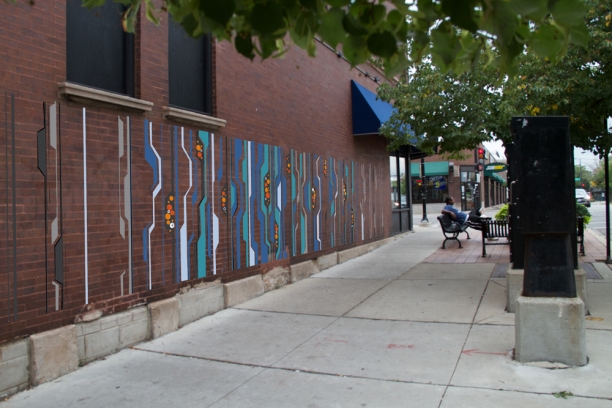
A month ago, artist Sarah Laing forwarded me the RFP issued jointly by the Andersonville Development Corporation and Good News Only. It was a tight timeline and given the budget constraints would necessarily be a painted composition with a small amount of integrated glasswork. Given Sarah's background in public art and painting I asked if she'd be interested in helping me navigate the world of painting on brick. Sarah has trained with several local public artists and has served on the board of the Chicago Public Art Group. Her recent projects include the Main St. Metra station mural in Evanston, a pedestrian underpass mural in West Andersonville and a current piece at Lincoln Elementary School in Evanston.
The exterior brick wall of the Adriatic Cafe is the first of a number of Andersonville sites identified for public art installations. This building is a beautiful 3-story brick buildings with curved corner windows that repeat at similar corners throughout Andersonville. The benches and plantings and generous sidewalk already create an inviting public space alongside the building. The goal is to create an engaging visual experience with coherent changes in form, velocity and intensity across the 30' span.
The glass work is complete and ready to be framed in anodized aluminum which manages the transition between paint+brick and glass+grout. Popping circles were subcut for a safe, durable installation and then floated on the panels to suggest the energy and light of the urban world. I mixed in iridescent glass to catch light in evening and low-light conditions. It'll be interesting to see how the glass functions at different times of day and in different light conditions.
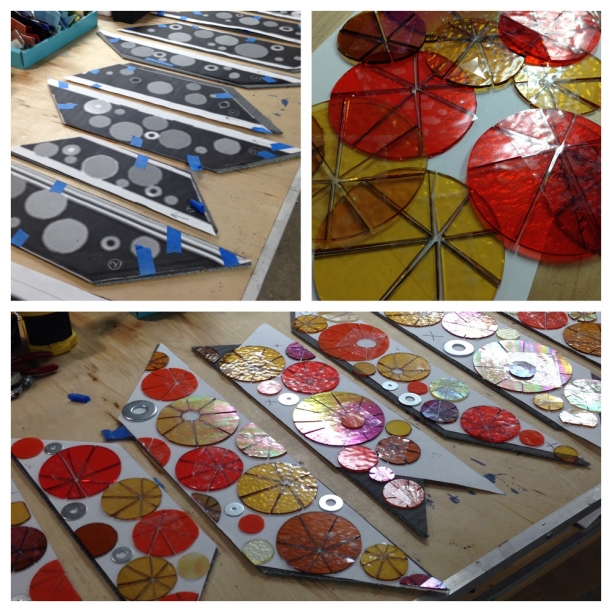
Planning for glass elements to be cut in ambers and oranges. The graphic lines will be painted in grays and blues.
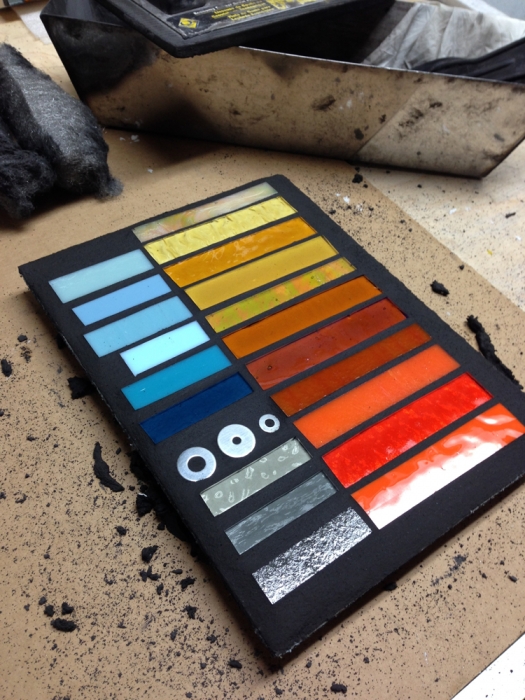
The unpainted brick is considered part of the composition in Link. The brick wall is in great condition so love the idea of paint+glass elements floating over existing brick, creating a composition that is fully integrated with the entire wall. The palette should both tie-in with the brick wall and also pop against it.
I am delighted that Impel 5.3 is featured in an article, House to Home, by Kelly Konrad in the October edition of Make it Better. Kelly was looking at how custom elements and finishes can be used to create a unique space. Kelly wrote a fantastic introduction to my art practice, including my interests in the importance of living with art and its role in engaging us on a daily basis.
 Squeezed in a long weekend of camping and hiking in the UP before settling into fall here. We camped on a bluff overlooking Lake Superior. Root-lined paths took us through ancient hemlock stands, along waterfalls and intriguing rock formations and to the rocky shoreline of Lake Superior. Another hike gave us views into Lake of the Clouds on one side and the vast great lake on the other. Definitely the best hiking experience yet in the midwest. We'll need to go back for more.
Squeezed in a long weekend of camping and hiking in the UP before settling into fall here. We camped on a bluff overlooking Lake Superior. Root-lined paths took us through ancient hemlock stands, along waterfalls and intriguing rock formations and to the rocky shoreline of Lake Superior. Another hike gave us views into Lake of the Clouds on one side and the vast great lake on the other. Definitely the best hiking experience yet in the midwest. We'll need to go back for more.
A last minute cancellation of a downtown meeting left me with time to wander in the Lurie Gardens at Millennium Park this morning. The gardens are truly amazing against the backdrop of downtown Chicago. The color and foliage is still impressive in early September and the sheer variety in plantings is incredible. I need to get back there with my Canon. But today it felt like my morning was salvaged by a stroll through the gardens and a Grant Park Orchestra concert.
